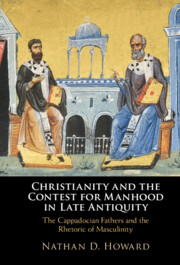 Christianity and the Contest for Manhood in Late Antiquity
Christianity and the Contest for Manhood in Late Antiquity Book contents
- Christianity and the Contest for Manhood in Late Antiquity
- Christianity and the Contest for Manhood in Late Antiquity
- Copyright page
- Dedication
- Contents
- Acknowledgments
- A Note on Translations
- Abbreviations
- The Cappadocian Fathers and their Families
- Introduction
- 1 “The Sweat of Eloquence”
- 2 The Agōn of Friendship
- 3 Hagiography and Masculinity
- 4 Agōn and Theological Authority
- Epilogue
- References
- Index
Epilogue
Classical Masculinity in Early Medieval and Byzantine Christianity
Published online by Cambridge University Press: 10 November 2022
- Christianity and the Contest for Manhood in Late Antiquity
- Christianity and the Contest for Manhood in Late Antiquity
- Copyright page
- Dedication
- Contents
- Acknowledgments
- A Note on Translations
- Abbreviations
- The Cappadocian Fathers and their Families
- Introduction
- 1 “The Sweat of Eloquence”
- 2 The Agōn of Friendship
- 3 Hagiography and Masculinity
- 4 Agōn and Theological Authority
- Epilogue
- References
- Index
Summary
The Epilogue identifies classical masculinity as reflected in depictions of late antique clothing,liturgy in Carolingian monasteries, and miniature illustrations in middle-Byzantine manuscripts. Fifth-century clergy wore specific apparel to signify manhood. Benedictine lectors (readers) were selected according to their virility of voice. And Byzantine artists set clergy face to face in manuscripts, in part a legacy of the agōn trope of reciprocal strength. These examples show that elements of classical masculinity continued to inform the Christian church in western Europe and Byzantium into the eleventh century. Such representations continued to evoke power and authority within the hierarchy of the church.Like fourth-century agōn rhetoric, these trappings of classical manhood provided a language of hierarchy for church leaders to integrate into a faith that lacked comparable platforms for displays of social and spiritual distinction.
Keywords
- Type
- Chapter
- Information
- Christianity and the Contest for Manhood in Late AntiquityThe Cappadocian Fathers and the Rhetoric of Masculinity, pp. 272 - 277Publisher: Cambridge University PressPrint publication year: 2022
